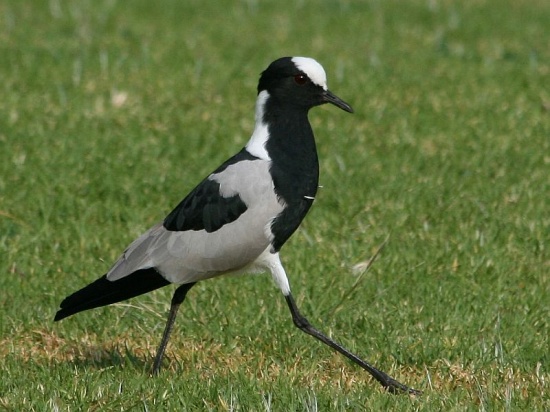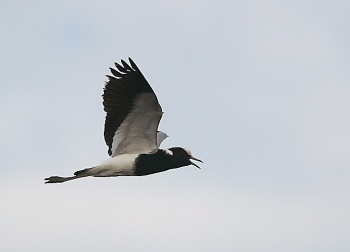
Photo © by Alan Manson
Walter Sisulu Botanical Gardens, Johannesburg, South Africa, April 2007
Alternative name: Blacksmith Plover
- Vanellus armatus
Identification
28–31 cm (11-12¼ in)
- White belly, nape patch, underwings, rump
- Grey upperwing-coverts
- Tail black and white
- Rest of plumage black
- Carpal wing spurs (sometimes hidden in feathers)
- Red eyes
- Very long legs
Sexes similar
Distribution
Africa, south of the Sahara:
Western Africa: Democratic Republic of Congo, Angola
Eastern Africa: Ethiopia, Kenya, Tanzania, Zambia, Mozambique, Malawi
Southern Africa: Namibia, Botswana, Zimbabwe, South Africa, KwaZulu-Natal, Lesotho, eSwatini
Taxonomy
This is a monotypic species[1].
Habitat
Pairs and scattered individuals frequent the shores of a wide variety inland waters and in marshy ground, flooded fields and other moist places.
Behaviour
Diet
Their diet consists of insects, worms, snails, seeds, molluscs and crustaceans.
Breeding
The nest is a ground scrape, formed by both adults. The clutch contains 4 eggs; incubation starts once the last egg is laid and lasts for 23-31 days. Both parents incubate the eggs.
Vocalisation
Call: Clink, clink (sounding like a blacksmith hammering metal).
References
- Clements, J. F., P. C. Rasmussen, T. S. Schulenberg, M. J. Iliff, T. A. Fredericks, J. A. Gerbracht, D. Lepage, A. Spencer, S. M. Billerman, B. L. Sullivan, M. Smith, and C. L. Wood. 2024. The eBird/Clements checklist of Birds of the World: v2024. Downloaded from https://www.birds.cornell.edu/clementschecklist/download/
- Lepage D. (2021) [Avibase - https://avibase.ca/2F23EDC6]. Retrieved 16 January 2021
- Honolulu Zoo
- BF Member observations
- Wiersma, P., G. M. Kirwan, and P. F. D. Boesman (2020). Blacksmith Lapwing (Vanellus armatus), version 1.1. In Birds of the World (S. M. Billerman, Editor). Cornell Lab of Ornithology, Ithaca, NY, USA. https://doi.org/10.2173/bow.blaplo1.01.1
Recommended Citation
- BirdForum Opus contributors. (2025) Blacksmith Lapwing. In: BirdForum, the forum for wild birds and birding. Retrieved 17 May 2025 from https://www.birdforum.net/opus/Blacksmith_Lapwing
External Links
GSearch checked for 2020 platform.1






